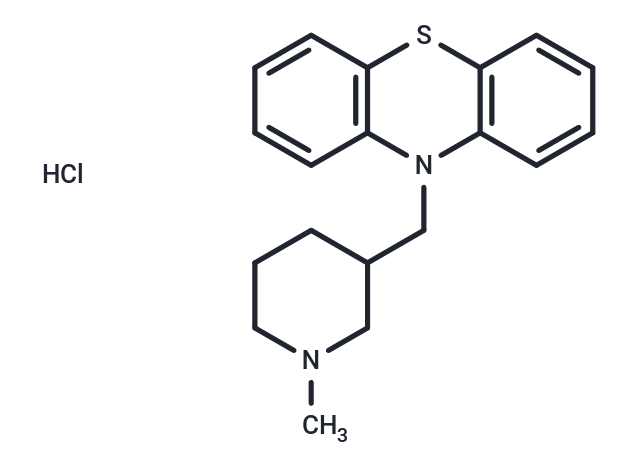Shopping Cart
Remove All Your shopping cart is currently empty
Your shopping cart is currently empty
Mepazine hydrochloride (Pecazine hydrochloride) is a potent MALT1 inhibitor with anticancer and antitumor activities. Mepazine hydrochloride inhibits RANK-induced osteoclastogenesis, suppresses MALT1 activity and tumor growth in pancreatic cancer.

| Pack Size | Price | USA Warehouse | Global Warehouse | Quantity |
|---|---|---|---|---|
| 5 mg | $35 | - | In Stock | |
| 10 mg | $56 | - | In Stock | |
| 25 mg | $89 | - | In Stock | |
| 50 mg | $128 | - | In Stock | |
| 100 mg | $187 | - | In Stock | |
| 1 mL x 10 mM (in DMSO) | $40 | - | In Stock |
| Description | Mepazine hydrochloride (Pecazine hydrochloride) is a potent MALT1 inhibitor with anticancer and antitumor activities. Mepazine hydrochloride inhibits RANK-induced osteoclastogenesis, suppresses MALT1 activity and tumor growth in pancreatic cancer. |
| Targets&IC50 | GSTMALT1 FL:0.83 μM, GSTMALT1 325-760:0.42 μM |
| In vitro | Mepazine hydrochloride was most effective in inhibiting GSTMALT1 FL and GSTMALT1 325-760 with IC50 values of 0.83 and 0.42 μM. Mepazine hydrochloride had the strongest effects and MALT1 activity was reduced by at least 75% in all ABC-DLBCL cells at 10 μM. Mepazine hydrochloride and thioridazine treatment led to a significant decrease of IL-2 secretion in PBMCs. [1] |
| In vivo | Mepazine hydrochloride and thioridazine could also exert effects on lymphoma growth in vivo in a murine DLBCL xenogeneic tumor model. Starting 1 day after injection, the mice were treated by intraperitoneal (i.p.) administration of solvent or either Mepazine hydrochloride (16 mg/kg) or thioridazine (12 mg/kg). In control-treated mice, massive tumors grew from both DLBCL cell lines within 3 weeks of transplantation. Daily administration of Mepazine hydrochloride or thioridazine strongly impaired the expansion of the ABC-DLBCL cell line OCI-Ly10. Mepazine hydrochloride and thioridazine strongly reduced the progression of OCI-Ly10 tumors while having no effect on the growth of Su-DHL-6 tumors in this setting. [1] |
| Synonyms | Pecazine hydrochloride |
| Molecular Weight | 346.92 |
| Formula | C19H23ClN2S |
| Cas No. | 2975-36-2 |
| Smiles | Cl.S1C=2C=CC=CC2N(C=3C=CC=CC13)CC4CN(C)CCC4 |
| Storage | store at low temperature,keep away from moisture | Powder: -20°C for 3 years | In solvent: -80°C for 1 year | Shipping with blue ice/Shipping at ambient temperature. | ||||||||||||||||||||||||||||||||||||||||
| Solubility Information | DMSO: 40 mg/mL (115.3 mM), Sonication is recommended. H2O: 1 mg/mL (2.88 mM), Sonication is recommended. | ||||||||||||||||||||||||||||||||||||||||
| In Vivo Formulation | 10% DMSO+40% PEG300+5% Tween 80+45% Saline: 2 mg/mL (5.77 mM), Sonication is recommended. Please add the solvents sequentially, clarifying the solution as much as possible before adding the next one. Dissolve by heating and/or sonication if necessary. Working solution is recommended to be prepared and used immediately. The formulation provided above is for reference purposes only. In vivo formulations may vary and should be modified based on specific experimental conditions. | ||||||||||||||||||||||||||||||||||||||||
Solution Preparation Table | |||||||||||||||||||||||||||||||||||||||||
H2O/DMSO
DMSO
| |||||||||||||||||||||||||||||||||||||||||
| Size | Quantity | Unit Price | Amount | Operation |
|---|

Copyright © 2015-2025 TargetMol Chemicals Inc. All Rights Reserved.